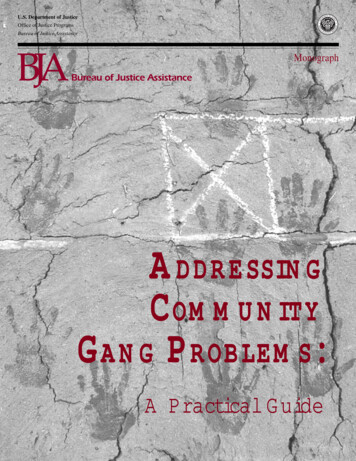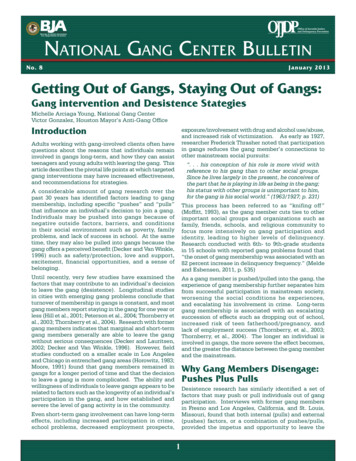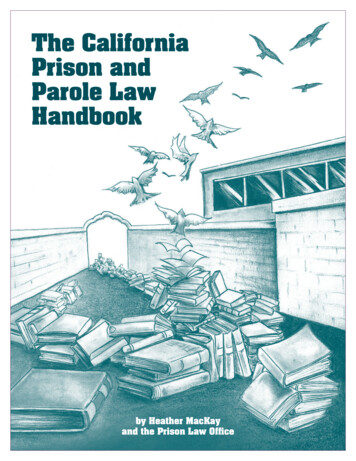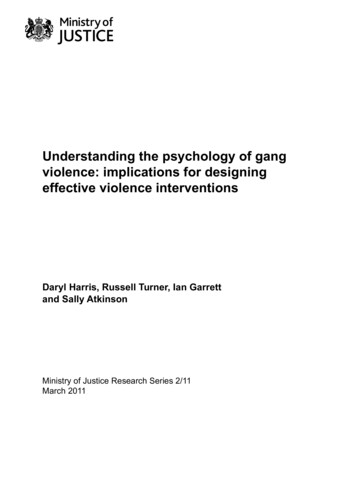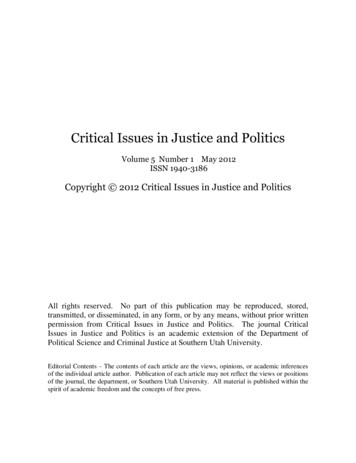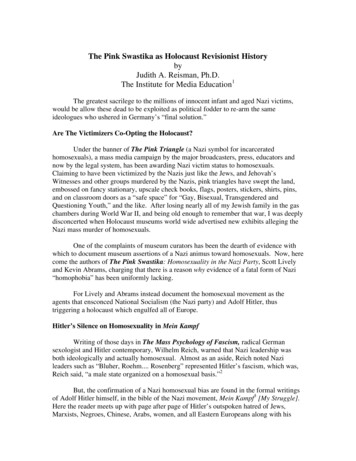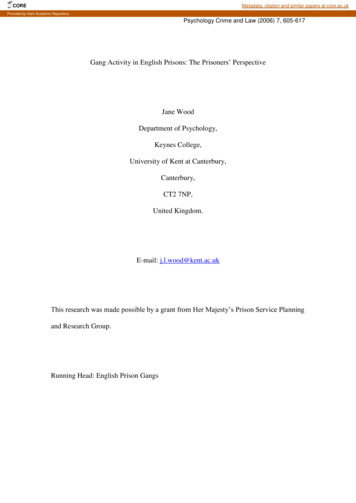
Transcription
COREMetadata, citation and similar papers at core.ac.ukProvided by Kent Academic RepositoryPsychology Crime and Law (2006) 7, 605-617Gang Activity in English Prisons: The Prisoners‟ PerspectiveJane WoodDepartment of Psychology,Keynes College,University of Kent at Canterbury,Canterbury,CT2 7NP,United Kingdom.E-mail: j.l.wood@kent.ac.ukThis research was made possible by a grant from Her Majesty‟s Prison Service Planningand Research Group.Running Head: English Prison Gangs
English Prison GangsGANG ACTIVITY IN ENGLISH PRISONS: THE PRISONERS‟ PERSPECTIVEGang activity in American prisons has resulted in serious problems for prisonersand staff (e.g. Fong & Buentello 1991; Stevens 1997). This study assessed prisoners‟perceptions of gang-event frequency in the U.K. Interviews with 360 prisoners from 9prisons in England and Wales indicated gang-related events were perceived as morefrequent in all male categories of prison than they were in female institutions. Prisonersreported drug possession and prisoner groups being formed along regional origins as themost frequent gang related activities. Recidivists perceived higher levels of gang relatedactivity than did first time prisoners. Gang related variables also predicted prisoners‟perceptions that groups of prisoners have more control over events in the prison than dostaff and that order in the prison may not be maintained. The merits of interviewingprisoners and the implications of the results for maintaining order in prison arediscussed.Key words: Prison Gangs, Prison Violence, Order, Control1
English Prison GangsACKNOWLEDGEMENTSThis study could not have been completed without the efforts of many people. The firstgroup to whom I owe a debt of gratitude is of course, the participants. I should like tothank them for their time and the consideration they gave to the questions. Specialthanks go the prison staff who took the time to accommodate the needs of the study.Much is also owed to the governing governors who granted research access even thoughover stretched resources sometimes made this difficult. In addition, I should like tothank the Prison Service for funding the research. Without this financial support thebroad scope of the study would have been particularly difficult.2
English Prison GangsINTRODUCTIONAmerican research indicates that prison gangs have become a formidable feature ofmany Federal and State prisons (e.g. Buentello, Fong & Vogel, 1991; Camp & Camp,1985; Jacobs, 1977). In the U.K. only one study (Wood & Adler 2001) has directlyexamined the issue of prison gangs in the English and Welsh prison estate. It revealedthat prison staff perceive many gang-related activities as common occurrences inEnglish prisons. The present study builds on this knowledge by examining prisoners‟perceptions of gang-related activities in English prisons.There is no precise definition of a prison gang; some argue (e.g. Fong &Buentello, 1991; Huff, 1996) that prison gangs are cohesive groups of prisoners (with aleader), whose criminal activities negatively impact on the prisons that hold them.Others contend that prison gangs have a more flexible configuration (e.g. Camp &Camp 1985). Also, research has not clarified the minimum number of members for anoperational definition of a “prison gang”. In light of these gaps in the literature, thisstudy defined a gang by borrowing from Brown‟s (2000) definition of a group and fromFong and Buentello‟s (1991) outline of a prison gang. Brown (2000) defines a group asexisting when “two or more people define themselves as members of it and when itsexistence is recognised by at least one other.” (p.2-3). For pragmatic purposes, sinceparticipants may not consider two people to be a group, the number used in the currentstudy was three or more people. A prison gang was therefore defined as a group of threeor more prisoners whose negative behaviour has an adverse impact on the prison thatholds them.The largest survey into the existence of prison gangs reported their presence in60% of Federal and State prisons (Camp & Camp, 1985). Prison gangs reportedly3
English Prison Gangsincluded 2% (12,634 prisoners) of the prison population and were thought to beresponsible for more than 50% of prison management problems (Camp & Camp, 1985)leading in some case to the declaration of a state of emergency (Beaird, 1986; Fong,1990).Prison gangs have continued to develop into organisations with connections andactivities stretching from prison to the community (Fong & Buentello, 1991; Sullivan,1991). They function on the acquisition of money and power (Camp & Camp, 1985;Fong, 1990) and use threats and violence to dominate staff and other prisoners (Huff,1996; Irwin, 1980; Stevens, 1997). In the U.S.A. the most common activities of prisongangs are reported to be, [in descending order]: intimidation; drug trafficking; assault;abuse of weaker prisoners; extortion; protection; contraband weapons; theft; “strongarm robbery”; rackets; robbery; prostitution; rape; “sodomy for sale”; murder; bribery;arson; slavery and explosives (Camp & Camp, 1985). Stevens (1997) found that in aprison where prison gangs were active 73% of non-gang prisoners wanted a transfer and87% would like to ask for protective custody but feared the consequences. Gangmembers are uninterested in schemes to earn privileges or address offending behaviour(Huff, 1996). However, they generally co-operate with prison staff requests and prisonrules and only become violent if opposed by prison staff (Camp & Camp 1985). On theother hand more recent evidence suggests that gang members are frequently violent andconsistently involved in almost all other forms of illicit behaviour (Gaes et al 2002). Inthe U.K. research reveals high levels of many gang related events such as drugpossession; groups formed by race; requests for transfers; prisoner/prisoner assaults; andregional affiliations occur across all categories of prison (Wood & Adler, 2001). The4
English Prison Gangslevels of these activities predicted staff perceptions of reduced order and control in theprison.Nonetheless, there is still a paucity of research into prison gangs. In the U.S.A.researchers note that officials often do not accept that a prison gang problem exists(Fong & Buentello, 1991). There is also the difficulty of accessing gang members whomay abide by a code of secrecy to protect members from official detection and transferto gang blocks reserved for prison gang members (Camp & Camp, 1985; Fong &Buentello, 1991). Calls for a more research-led proactive approach to the managementof prison gangs have resulted from the recognition that the existence of prison gangstends to be recognised only following a crisis and that rectifying the situation is oftencostly (Fong & Buentello, 1991). Fong and Buentello (1991) contend that a proactiveapproach would result in research establishing the existence and activities of prisongangs before they become organised and possibly disruptive.So far, research has relied mainly on prison staff reports or prison records (e.g.Camp & Camp 1985; Fong & Buentello 1991; Huff 1996; Wood & Adler 2001; Gaes etal 2002).While staff accounts and records may be useful to begin examining prisongangs there will be limitations to the insight prison staff can offer. Canadian researchindicates that staff awareness of prisoner activity is limited (Cooley 1993). Prison staffmay not be fully aware of the frequency with which certain events occur. Similarly,problems such as low morale, lack of job satisfaction, or even stereotypical views ofprisoners‟ behaviour may colour staff accounts.The problems associated with staff perspectives also apply to the use of officialprison data; a methodology favoured by some (e.g. Camp & Camp 1985; BuentelloFong and Vogel 1991). If staff assessments of prisoners‟ behaviour are limited or5
English Prison Gangsflawed, then prison records compiled by staff will reflect those inaccuracies. Also, thecontradictory sources of official information available, i.e. log books, landing books,observation books and adjudication data make prison records an erratic source ofevidence.The most logical alternative to the above methodologies is to ask prisoners fortheir perceptions of „gang-related‟ events in prison. Some American researchers arguethat prisoners would not cooperate with this kind of research (e.g. Fong & Buentello1991) while others have found that prisoners are willing to report confidentially theactivities of prison gangs (e.g. Stevens 1997). Since only a small number of prisoners,2% (Camp & Camp 1985) and 10% (Knox 1994) are gang members this means thatmost prisoners are not prison gang members. If prison gangs are as predatory as theliterature suggests then non-gang prisoners are likely to have been victimised by thesegroups. These prisoners, if assured of confidentiality, may be willing to speak toresearchers. Also, even prison gang members may not be as reticent as suggested (e.g.Fong & Buentello 1991) since Koehler (2000) found that more than 90% of a wellorganised gang were willing to be interviewed about their gang membership but notabout involvement in criminal activity. Consequently, this study built on the work ofWood and Adler (2001) by examining prisoners‟ perceptions of gang related activityand order and control in the prison.Although gang related activity in the U.K. may have similar patterns to thoseobserved in the U.S.A. there could also be some fundamental differences. For example,American researchers note how prison gangs form along racial lines, just as street gangsdo. In the U.K. street gangs form along regional lines (Mares, 2001) and prison gangsmay do the same. Also, there are fundamental differences between the American and6
English Prison GangsEnglish and Welsh prison systems that may influence the existence and/or emergence ofprison gangs. For example, in Quentin (a high security establishment) the ratio ofofficers to prisoners is 1:190 and even in the block where prison gangs are known to beactive the ratio is 1:16. In English and Welsh prisons, prisoners experience a greaterstaff presence than their counterparts in the U.S.A. The official ratio of officers toprisoners in England and Wales is one officer per 2.5 prisoners (category B), one officerper 1.3 (category C) one officer per 1.9 (YOI) and one officer per 1.9 (females)(Function Report, H.M. Prison Service 2005). However, these figures may differbetween wings in different prisons and so some prisoners may have more supervisionthan others, even within categories. Nevertheless, the suggestion here is that generallyprisoners in the U.K. are supervised to an extent that may hinder the development andfunctioning of prison gangs.Taking potential differences into account this study used key indicators of prisongang presence identified by Buentello et al (1991) together with items developed for theEnglish and Welsh prison system by Wood and Adler (2001). Since staff perceptions ofprison gang activity related to staff reports of reduced control and order in prison (Wood& Adler 2001) this study also aimed to see if prisoners‟ reports reflected a similarrelationship between gang event frequency and perceived order and control.As previous research notes that category C (medium/low security); Femaleestablishments (classified as open/closed: hold females from 15 years old); YoungOffenders‟ Institutions (male offenders aged 15-21 years) and Category B prisons(medium/high security) are the establishments particularly vulnerable to gang relatedactivity, these were included in this study. Dispersal prisons (Highest security) and7
English Prison GangsOpen prisons (Low security) were not included since staff reports indicated lower levelsof gang-related activity (Wood & Adler, 2001).However, it is possible that prisoners‟ and staff perceptions of gang related activitymay differ due to environmental features of the institutions. For instance, some femaleestablishments are designed on the basis of 'houses' and aim to establish a pattern of'home' and 'the neighbours' (Kelley 1970). In such a penal structure, gang-relatedactivities may occur in isolated pockets throughout the prison, leaving many prisonersoblivious to their occurrence, which may be reflected in the levels of events reported.Prison staff are unlikely to be equally oblivious since their diverse duties provide themwith an overall insight into the prison and its events.Demographic and institutional variables were also examined since Americanresearch indicates that gang members have served more sentences, take more drugs andhave longer sentences than non gang prisoners (Sheldon 1991). They are also likely tobe younger than non gang prisoners (Ralph, Hunter, Marquart, Cuvelier and Merianos1996). If this also applies to the U.K., it could be expected that prisoners most involvedwill be able to provide the greatest insight into gang related events, since some gangrelated events are covert and therefore not as visible to other prisoners or staff.Subsequently, younger prisoners, those serving longer sentences, and recidivists mayreport higher levels of events. Ethnic origin was included due to self-classificationhaving a possible bearing on how prisoners perceive themselves in terms of race. Forexample, prisoners of mixed race may consider themselves to be either black or whiteand if prisoner groups form along racial lines as suggested by gang researchers (e.g.Camp & Camp 1985) this may influence the prisoner‟s choice of associates and theinformation they are privy to.8
English Prison GangsHypotheses:H1) Since prison staff reported that gang related events were highest in category C andYoung Offender Institutions, it is expected that prisoners will also report thesecategories as having the highest levels of gang related events. Category B prisonersand female prisoners are expected to report the lowest levels of gang relatedactivity.H2) It is expected that prisoners will hold similar perceptions to staff inasmuch as thosewho perceive high levels of gang related events will also perceive prisoner groupsas having more control over events in the prison than do staff (prisoner control).H3) It is expected that prisoners will hold similar perceptions to staff inasmuch as thosewho perceive high levels of gang related events will also perceive that staff may notmaintain order in the prison (staff order).H4) It is expected that prisoners involved in gang related activity will be more aware ofthe actual levels of gang related activity and so reports of gang related activity willbe predicted from demographic and institutional factors such as age, length ofsentence and recidivism.METHODParticipantsThree hundred and sixty prisoners from nine prisons participated (see Table 1for sample demographics). In eight of the nine prisons every 5th or 7th prisoner wasselected from a list of all prisoners. In the ninth prison, prisoners were approached andasked to participate by either the researcher or prison staff. Subsequently of the 360prisoners who took part in this study 40 resulted from opportunistic rather than randomsampling.9
English Prison GangsPrisoners held on remand were not selected since they were less likely thanconvicted prisoners to be aware of other prisoners‟ activities. Of those asked to take partin the research, three prisoners held in category C institutions and two prisoners in thecategory B establishment, --TABLE 1 TO GO erialsInterview items were based on the extension of Fong et al‟s (1991) questionnairedeveloped by Wood and Adler (2001) and adapted for use with prisoners for this study.Fong et al‟s original variables included 11 items assessing: prisoner requests forprotective custody, prisoners with tattoos, prisoner disciplinary violations of contrabandpossessions, secret racial groupings of prisoners, the emergence of prisoner cliques,physical assaults on other prisoners, prisoners‟ involvement in illicit activities withpeople outside prison, prisoner requests for inter-unit transfers, prisoners‟ families beingthreatened by prisoner cliques, verbal threats made to staff by prisoners, physicalassaults on staff by prisoners. For clarity, Fong and Buentello's (1991) variable“prisoner possession of contraband” was divided into four specific variables concerningpossession of alcohol, drugs, phone cards and tobacco as these were considered to bethe most common forms of contraband in English and Welsh prisons.Variables added by Wood and Adler (2001) were based on knowledge of theEnglish prison system and American findings. Items used to assess the dominance ofsome prisoners by prisoner groups and the frequency of opposing groups' disputes were10
English Prison Gangsincluded since these are likely to be common examples of group behaviour in prison(Wood & Adler 2001). Wood and Adler‟s additional items also expanded Fong et al‟s(1991) racial basis for group formation to include regional and ideological criteria;factors acknowledged as a basis for group formation by American and U.K. researchers(e.g. Camp & Camp; 1985, Rush, Stone & Wycoff, 1996; Mares, 2001). For example,prisoners were asked to report levels of membership of extreme political organisations(e.g. The British National Party) and the domination of prisoners‟ groups by suchmembers. Given that concerns and fear over personal safety have been found toproliferate in English prisons (Adler, 1998), an item was used to assess prisoners‟concerns for their safety. Two variables were used to examine prisoners‟ perceptions oforder and control in the prison. The first assessed perceptions that groups of prisonershave more control over events in the prison than do staff and the second assessedperceptions that staff may lose control of the prison. These were based on Americanfindings that prison gangs flourish where they can control staff and other prisoners(Stevens' 1997) and that prison gang presence leads to a breakdown in order (e.g. Beird1986; Fong 1990). The occurrence of the events alone cannot be taken as an indicator ofprison-gang presence (Fong et al. 1991). If a number of events occur “frequently” or“very frequently”, or there is a sudden rise in levels of occurrence, then this should giverise to concerns that prison gangs may be operating in the prison. Subsequentlyprisoners were asked to report the frequency of each event.Internal reliability analysis indicated that the scale was reliable ( .86).Although prisoners were asked items relating to groups of three or more, the phrase“prison gang” was not used. This was to avoid experimental demand i.e. the possibility11
English Prison Gangsthat some prisoners may have preconceived ideas about prison gangs, which couldinfluence their responses.ProcedureInterviews were conducted individually and in private. Participants were fullybriefed of the study's aims and their rights to confidentiality and anonymity beforeinterviews began. At the request of the Prison Service, participants were told before theinterview that if they revealed an intention to escape, harm themselves or anotherperson, this information could not remain confidential. To control for an order effect,items on the questionnaires were rotated to produce 4 different versions. Respondentswere randomly presented with one of the 4 versions. Questions were read to participantsto allow for any literacy difficulties and respondents were asked to report only eventsthat had occurred in the current prison within the last six months. Each interview lastedapproximately 20 minutes after which participants were invited to ask questions beforebeing debriefed verbally and in writing.RESULTSTo get a clearer idea of the type and frequency of gang-related events, thepercentage of prisoners who reported an event as occurring frequently (11-20 times) orvery frequently (more than 20 times) within the preceding 6 months were calculated. AsTable 2 shows, the event considered by prisoners to be the most frequent was prisonerspossessing drugs. Other common events seem to function on cohesion of groups orpossession of material goods and seem to occur more frequently than do events relatingto domination of, or altercations between, ERT TABLE 2 ABOUT HERE12
English Prison ----------------------------------------To examine categories of prison according to perceptions of gang-related events,individual scores for each event were summed to give a total for each participant. Aone-way ANOVA revealed a difference between perceived levels of events according tocategory of prison, F (3,355) 4.46, p .005, η .04, power .88. Tukey's post hocanalysis revealed that male prisoners in Categories B (M 58.15), C (M 57.37), andYOI (M 58.17) reported similar levels of events, but female prisoners reported fewergang-related events (M 51.33) than all other categories.Gang events as predictors of reduced order and control in prisonThe data were analysed to see if prisoners who perceived high levels of gangrelated events also perceived high levels of prisoner control and a reduction in stafforder. Although the variables „prisoner control‟ and „staff order‟ were assessed as partof the gang events scale they were used only as D.V.‟s for the purpose of analysis.Perceptions of „prisoner control‟To see if prisoners who perceived high levels of gang related events alsoconsidered prisoner groups to have more control over events in the prison than do staff,(prisoner control) a standard regression analysis using gang related events as IV‟s andprisoner control as the DV was conducted. Results revealed the independent variablessuccessfully predicted the DV and explained 13% of the variance (see Table 3). TheBeta coefficients for the important predictors reveal that as each predictor increases sotoo do perceptions that prisoners have more control over events in the prison than dostaff.13
English Prison -------------------------------------------INSERT TABLE 3 ABOUT tions of „staff order‟The second standard regression analysis used prisoners‟ perception that staffmight not maintain order in the prison‟ (staff order) as the DV and prisoners‟perceptions of gang events as the IV‟s. Results showed that the IV‟s successfullypredicted the DV accounting for 29% of the variance (see Table 4). Beta valuesindicated, with one exception, that as each IV increases so too do prisoners‟ perceptionsthat staff may not maintain order in the prison. The IV prisoners belonging to outsideorganisations dominating prisoner groups has a negative Beta value indicating that thisvariable has a negative relationship with reduced staff ------------------------------------INSERT TABLE 4 ABOUT -------------------------------------Perceptions of gang event frequency and demographic/institutional characteristicsA standard regression analysis was used to see if demographic and institutionalcharacteristics related to prisoners‟ perceptions of gang events. The total score forperceived level as of gang-related events was used as the DV and age, ethnic origin,gender, number of prison sentences served and length of the current sentence were used14
English Prison Gangsas IVs. Since 46.4% of participants were serving a first prison sentence the number ofprison sentences served was split into prisoners serving a first prison sentence (naïve)and prisoners serving a subsequent prison sentence (recidivist). The analysis showedthat prisoners perceiving the highest levels of gang related events were young, male --INSERT TABLE 5 ABOUT NThis study had four hypotheses, two were supported by the results and two werepartially supported. The first hypothesis anticipated that reports of gang-related eventswould be highest in category C prisons and Young Offender Institutions. Category Bprisoners‟ and female prisoners‟ reports would be the lowest. Only partial support wasfound for this prediction. Although gang-related events were perceived as more frequentin all male categories of prison than they were in female institutions, male institutionsdid not differ from each other.This finding echoes American observations that female prisoners are not as involvedas male prisoners in prison gang activity (e.g. Knox 1994). Female prisoners‟ reports ofevents also seem to differ from levels reported by prison staff in the Wood and Adler(2001) study. Wood and Adler‟s findings suggested that female establishments did notdiffer from male establishments with the exception of category C prisons. As notedearlier some female establishments reflect a neighbourhood structure (Kelley 1970),which may mean that gang-related activities occur in isolated pockets leaving some15
English Prison Gangsprisoners less aware of gang related activity than staff. Equally, if the prison replicates a„neighbourhood‟ then cohesive group formation could be a normal feature of theenvironment rather than a matter of prisoner choice. Of the two female prisons that tookpart in this study, one was organised according to „houses.‟ Hence, it is feasible that theinfluence of this one establishment was sufficient to shape the results.The second hypothesis predicted that the frequency of gang related events wouldpredict prisoners‟ perceptions of prisoner groups having more control over events in theprison than did staff. This prediction was supported. As expected, gang related variablespredicted prisoners‟ perceptions of groups of prisoners having more control over eventsthan do staff. This supports American and British findings that activities associated withprison gangs relate to prisoners having increased control over events in the prison(Camp & Camp, 1985; Fong & Buentello, 1991; Stevens, 1997; Wood & Adler, 2001).The key predictors of „prisoner control‟ included a combination of overt andcovert gang-related activities. Overt events included verbal threats to staff and groups ofprisoners verbally dominating other prisoners. These indicate intimidation of otherindividuals; a central feature of the prison gang (e.g. Camp & Camp 1985). Anotherimportant predictor of prisoner control was requests for protective custody. Thissupports previous findings that requests for protective custody rise when prison gangsare present due to threats, assaults and intimidation experienced by non gang prisoners(Stevens 1997).The possession of alcohol as an important predictor of „prisoner control‟ isinteresting. Unlike many contraband materials such as drugs, alcohol is a relativelybulky product and not easy to conceal so it may require a level of freedom orresourcefulness to prevent staff finding it. A certain level of expertise or freedom would16
English Prison Gangsalso be necessary to produce it inside or import it into, the prison. If prisoners have highlevels of control over events in the prison, then the procurement and concealment ofalcohol is likely to be easier. Of course there is always the alternative explanation that inan environment where prison staff sense they lack full control, some may be tempted tooverlook the odd bottle of „hooch.‟ In such circumstances, it would be surprising ifprisoners did not report beliefs that prisoners have more control over events in theprison than do staff.Prisoners forming close knot groups as a key indicator of „prisoner control‟within the prison is not unexpected. What is not clear is whether close knit groups resultfrom or contribute to, high levels of „prisoner control.‟ It is possible that they do both.For example, prisoners intent on gaining and maintaining power may form groups asincreased numbers may help achieve this aim. These groups may then begin to exerttheir own „prisoner control‟ as they recognise and capitalise on their potential for powerwithin the prison. As their control increases other prisoners may band together forprotection and more close knit groups develop. Formation of groups for protection fromthe perceived threat of other groups is well documented in American research (e.g.Knox 1994; Klein 1995). As a result they may then develop into a prison gang(Buentello et al, 1991). In such an atmosphere it is only to be expected that prisonerswould conceive „prisoner control‟ as high.The third hypothesis predicted that the frequency of gang related events wouldpredict prisoners‟ perceptions that staff may not maintain order (staff order). Thisprediction was also supported. This supports American and British findings that gangactivity is associated with reduced order in the prison (Camp & Camp, 1985; Fong &Buentello, 1991; Stevens, 1997; Wood & Adler, 2001). Unsurprisingly, physical17
English Prison Gangsassaults on staff and verbal threats to staff were important predictors of „staff order.‟ Inan atmosphere where prisoners feel able to verbally threaten and particularly if they feelable to physically assault staff, it could be argued that order is already ebbing away. Theimportance of more covert variables such as threats to prisoners‟ families is interesting,as it was one of the less frequent activities cited by prisoners. Its importance as apredictor of „staff order,‟ may indicate a subtle effect of gang behaviour on „staff order‟in the prison. If groups of prisoners
Psychology Crime and Law (2006) 7, 605-617 Gang Activity in English Prisons: The Prisoners‟ Perspective Jane Wood Department of Psychology, Keynes College, University of Kent at Canterbury, Canterbury, CT2 7NP, United Kingdom. E-mail: j.l.wood@kent.ac.uk This research was made possible by a grant from Her Majesty‟s Prison Service Planning
